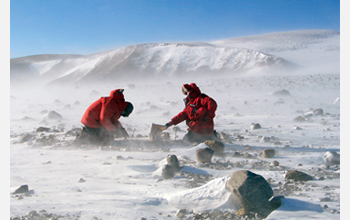
John Goodge and a colleague collecting specimens in the Transantarctic Mountains.
A lone granite boulder found against all odds high atop a glacier in Antarctica may provide additional key evidence to support a theory that parts of the southernmost continent once were connected to North America hundreds of millions of years ago.
Writing in the July 11 edition of the journal Science, an international team of U.S. and Australian investigators describe their findings, which were made in the Transantarctic Mountains, and their significance to the problem of piecing together what an ancient supercontinent, called Rodinia, looked like. The U.S. investigators were funded by the National Science Foundation (NSF).
Previous lines of scientific evidence led researchers to theorise that about 600-800 million years ago a portion of Rodinia broke away from what is now the southwestern United States and eventually drifted southward to become eastern Antarctica and Australia.
The team’s find, they argue, provides physical evidence that confirms the so-called southwestern United States and East Antarctica (SWEAT) hypothesis.
Find out more at the National Science Federation

No comments:
Post a Comment